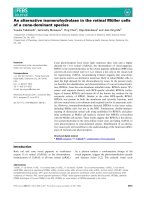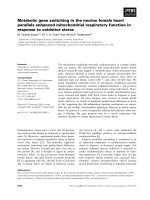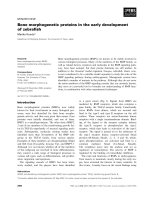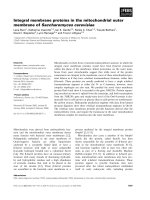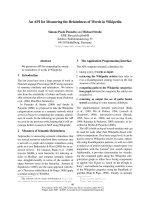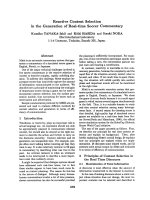Báo cáo khoa học: "Intraoperative radiation therapy in the treatment of early-stage breast cancer utilizing xoft axxent electronic brachytherapy" ppt
Bạn đang xem bản rút gọn của tài liệu. Xem và tải ngay bản đầy đủ của tài liệu tại đây (1.37 MB, 6 trang )
BioMed Central
Page 1 of 6
(page number not for citation purposes)
World Journal of Surgical Oncology
Open Access
Technical innovations
Intraoperative radiation therapy in the treatment of early-stage
breast cancer utilizing xoft axxent electronic brachytherapy
Adam Dickler*
1
, Olga Ivanov
2
and Darius Francescatti
3
Address:
1
Department of Radiation Oncology, Little Company of Mary Hospital, Evergreen Park, IL 60805, USA,
2
Department of General Surgery,
Little Company of Mary Hospital, Evergreen Park, IL 60805, USA and
3
Department of General Surgery, Rush University Medical Center, Chicago,
IL 60612, USA
Email: Adam Dickler* - ; Olga Ivanov - ; Darius Francescatti -
* Corresponding author
Abstract
Background: In an effort to overcome the barriers to BCT, alternative methods of delivering
radiation therapy have been explored. APBI allows the radiation treatment to be accomplished in
one week or less. XB is a form of balloon-based APBI that uses an electronic source generated by
a mobile controller unit. Investigators have also explored IORT treatment that delivers a single
fraction of radiation in the operating suite at the time of surgery.
Methods: We report on the first patient treated with XB to deliver IORT.
Results: IORT treatment utilizing XB is feasible and can be accomplished with a total procedure
time of approximately 2 hours.
Conclusion: Further research on XB and other methods of IORT is needed to establish clinical
efficacy and safety for patients with early-stage breast cancer.
Background
Several large randomized trials with extended follow-up
have shown that breast conserving therapy (BCT) offers
equivalent overall survival to modified radical mastec-
tomy in patients with early stage breast cancer [1,2]. Stud-
ies have also shown that in certain parts of the United
States, as few as 10% of eligible patients receive BCT [3,4].
Instead, some women are treated with mastectomy and
others receive lumpectomy alone. This is especially com-
mon for women who live at an increased distance from
radiation centers [5,6]. The logistical difficulties that
accompany a 6–7 week course of whole breast external
beam radiation (EBRT) are believed to be the main deter-
rent to patients receiving radiation therapy. Although
radiation therapy is burdensome, it is an important com-
ponent of BCT that cannot be safely omitted. EBRT has
been shown to both decrease the risk of local recurrence
and also to improve overall survival compared to surgery
alone [7].
In an effort to overcome the barriers to BCT, alternative
methods of delivering radiation therapy have been
explored. In contrast to standard EBRT, which treats the
whole breast, accelerated partial breast irradiation (APBI)
delivers radiation to the lumpectomy bed plus a 1–2 cm
margin only. By decreasing the volume of treatment and
increasing the daily fraction size of the radiation, treat-
ment can be accomplished in one week rather than the
standard 6–7 weeks.
The method of APBI with the longest published experi-
ence is multi-catheter interstitial brachytherapy. In this
Published: 2 March 2009
World Journal of Surgical Oncology 2009, 7:24 doi:10.1186/1477-7819-7-24
Received: 17 December 2008
Accepted: 2 March 2009
This article is available from: />© 2009 Dickler et al; licensee BioMed Central Ltd.
This is an Open Access article distributed under the terms of the Creative Commons Attribution License ( />),
which permits unrestricted use, distribution, and reproduction in any medium, provided the original work is properly cited.
World Journal of Surgical Oncology 2009, 7:24 />Page 2 of 6
(page number not for citation purposes)
technique, several rows of catheter needles are placed
around the lumpectomy bed and loaded with radiation
sources. Multi-catheter interstitial brachytherapy has been
associated with local recurrence rates of less than 5% at
over 5-years follow-up and favorable cosmesis [8,9].
Unfortunately, this technique is difficult and requires sig-
nificant expertise. As a result, multi-catheter interstitial
breast brachytherapy is performed at relatively few centers
in the U.S.
Balloon-based APBI methods were developed to simplify
the brachytherapy procedure. The MammoSite™ (MS)
brachytherapy applicator was the first balloon catheter to
be developed for APBI. The catheter contains an inflation
channel and a channel for the passage of an Iridium-192
(Ir-192) radiation source. It can be inserted through a sin-
gle incision at the time of surgery or post-lumpectomy
using ultrasound guidance. Initial results regarding cos-
mesis and local control using the MS catheter have been
comparable to multi-catheter interstitial brachytherapy
[10,11].
Additional methods of balloon-based APBI are also being
explored. A modified form of balloon-based brachyther-
apy called Xoft Axxent Electronic Brachytherapy™ (XB)
received FDA clearance for the treatment of breast cancer
in January, 2006. This device uses a mobile controller,
which generates kilovoltage (kV) x-rays. This approach to
APBI requires minimal shielding and thus has the poten-
tial to increase the number of settings in which radiation
treatments can be offered. In addition, XB is not limited
by rigorous radiation source regulations associated with
other methods of APBI, which utilize radioisotope
sources. The early results of a clinical trial to evaluate the
performance and safety of XB in the outpatient treatment
of early-stage breast cancer patients were recently pre-
sented at the American Society of Clinical Oncology
(ASCO) Breast Cancer Symposium. Treatment with XB
was found to be feasible and associated with minimal
acute side effects [12].
Investigators have also explored delivering APBI in the
operating room immediately after lumpectomy. Intraop-
erative radiation therapy (IORT) allows the patient to
receive all her radiation in a single fraction before she
awakens from surgery. Additional potential advantages
include delivering the radiation before tumor cells have a
chance to proliferate, performing the radiation under
direct visualization at the time of surgery, and decreasing
healthcare costs. Published results using IORT both as a
tumor bed boost in conjunction with EBRT and as a pri-
mary treatment in APBI have shown favorable outcomes
[13-15].
To date, XB has been utilized only in an outpatient setting
to deliver APBI in 10 fractions over 5 days. We report on
the first patient treated using XB to deliver IORT as part of
an IRB approved single-institution trial.
Patients and methods
The patient is a 61-year-old woman who presented with
an abnormal screening mammogram. It revealed an 8-
mm mass in the lower inner quadrant of the left breast.
She had a core biopsy performed that showed a Grade 1,
infiltrating ductal cancer that was estrogen and progester-
one receptor positive.
The patient was seen in consultation by her surgeon and
radiation oncologist. Radiation treatment options were
explained to the patient, including the standard of care, 6–
7 weeks of whole breast radiation therapy, and one week
of outpatient APBI. An IRB approved protocol utilizing XB
to deliver IORT was also discussed. The patient opted to
enroll in the IORT protocol.
On September 3
rd
, 2008, the patient underwent a lumpec-
tomy and sentinel lymph node biopsy. The tumor mass
and margins of excision were sent for permanent section,
and the identified sentinel lymph node was sent for fro-
zen section. The pathology department reviewed the
lymph node specimen at the time of surgery and informed
the treating physicians that it was uninvolved by cancer.
At that point, additional breast tissue was removed poste-
rior to the lumpectomy cavity down to the depth of the
superficial pectoralis fascia to accommodate the chest wall
shield. A pliable piece of lead was then temporarily placed
over the chest wall to shield the ribs, lung, and heart, from
scatter radiation. A cavity evaluation device (CED) was
then inserted into the lumpectomy cavity through a small
incision in the lateral breast and inflated with exactly 40
cc of saline (Figure 1). The conformity of the CED to the
surrounding breast tissue was then evaluated under direct
visualization. Conformance was considered to be accept-
able if less than 10% of the tissue immediately surround-
ing the breast tissue was composed of fluid or air and the
balloon was tightly opposed to the lumpectomy cavity.
Conformance was found to be inadequate, so an addi-
tional 10 cc of saline was inserted into the balloon. It was
found that conformance was still less than ideal, so an
additional 10 cc, or at total of 60 cc, was inserted into the
balloon.
Since a CED inflated to 60 cc was found to be the proper
size, a 4 × 5 cm XB balloon catheter kit was then opened
by the OR staff. The CED was then deflated and removed
and a XB was then inserted in place of the CED. If a 40 cc
balloon were to be used, a 3 × 4 cm catheter kit would
have been opened. The physicist then began calibration of
World Journal of Surgical Oncology 2009, 7:24 />Page 3 of 6
(page number not for citation purposes)
the XB controller. Radiation plans for a 40 cc, 50 cc, 60 cc,
and 70 cc balloon were previously developed by CT scan-
ning the XB catheter inflated with saline to the 4 sizes in a
water phantom. These plans were then loaded onto USB
drives. At the completion of calibration, which typically
takes approximately 15 minutes, the physicist then loaded
the corresponding radiation plan onto the controller unit.
During machine calibration, retention sutures were
placed in the breast tissue superficial to the inflated bal-
loon (Figure 2). The retention sutures serve to build-up
the subcutaneous tissue to potentially increase the bal-
loon-to-skin distance and to more closely approximate
the balloon to the surrounding breast tissue. An intraop-
erative ultrasound was then performed to evaluate the bal-
loon-to-skin distance and the degree of air and/or fluid in
the breast tissue surrounding the balloon. For the pur-
poses of this protocol, a minimum of 1-cm balloon to
skin distance is required. If the patients are found to have
≥ 0.7-cm and < 1.0-cm of balloon-skin-distance they are
offered outpatient balloon-based ABPI. If patients have a
balloon-skin-distance of < 0.7-cm, balloon-based brachy-
therapy is aborted. If patients are found to have large air
pockets surrounding the balloon on ultrasound, the bal-
loon is inflated by 10 cc to the next largest size and re-eval-
uated via ultrasound.
The patient was found to have 1.6-cm balloon-to-skin dis-
tance and no air pockets surrounding the balloon, so the
decision was made to proceed with IORT (Figure 3). A sec-
ond sterile drape was then placed over the operative field,
so that the radiation therapy could be delivered without
contaminating the field. The catheter end was passed
through a hole in the drape and a FlexiShield™ (FS) was
placed on top of the drape (Figure 4). The FS is a lead-
equivalent material, which serves to decrease transmis-
sion to the patient and hospital staff.
Results
The radiation oncologist then broke scrub, attached the
XB controller to the catheter, and inserted the radiation
source into the balloon. The radiation therapy was then
A CED is inserted through a small incision in the lateral breast and inflated with exactly 40 cc, 50cc, 60 cc, or 70 ccFigure 1
A CED is inserted through a small incision in the lat-
eral breast and inflated with exactly 40 cc, 50 cc, 60
cc, or 70 cc.
Retention sutures are placed to potentially increase the bal-loon-to-skin distance and to more closely approximate the balloon to the surrounding breast tissueFigure 2
Retention sutures are placed to potentially increase
the balloon-to-skin distance and to more closely
approximate the balloon to the surrounding breast
tissue.
Ultrasound image showing a balloon-skin-distance of 1.6-cm and no evidence of air pockets surrounding the balloonFigure 3
Ultrasound image showing a balloon-skin-distance of
1.6-cm and no evidence of air pockets surrounding
the balloon.
World Journal of Surgical Oncology 2009, 7:24 />Page 4 of 6
(page number not for citation purposes)
initiated. A total of 20 Gy to the balloon surface was deliv-
ered in approximately 20 minutes (Figure 5). The anesthe-
siologist, surgeon, and radiation oncologist remained in
the room during the radiation delivery either wearing lead
aprons or standing behind a mobile radiation shield. At
the completion of the radiation, the balloon and tempo-
rary chest wall shield were removed and the incisions were
closed. The duration of the entire procedure including
lumpectomy, sentinel lymph node biopsy, balloon cathe-
ter placement, radiation therapy, and closing the incisions
was approximately 2 hours.
Margin status was assessed by permanent section after the
completion of the surgery. Negative microscopic margins
are required in the protocol for treatment with IORT
alone. Patients who are found to have microscopically
positive margins of excision are offered re-excision and
whole breast EBRT. The patient was found to have mar-
gins of excision of over 2-mm
Discussion
XB is a novel form of balloon-based APBI, which uses an
electronic source to generate kV x-rays. This form of APBI
eliminates the need for an HDR afterloader device, heavy
shielding, and regulations associated with radiosotope
handling and disposal. In addition, XB increases the
number of settings in which radiation can be performed.
Early clinical reports have shown this technique to be fea-
sible and associated with minimal acute toxicity [12].
Also, XB has been compared to MS (a more established
form of balloon-based APBI) and found to offer equiva-
lent target volume coverage with increased normal tissue
sparing [16]. To date and since FDA clearance, XB has only
been used for outpatient treatment of breast and endome-
trial cancer. The mobile nature of the XB controller, as
well as, the limited shielding requirements make XB a log-
ical modality to be utilized for IORT in the treatment of
early-stage breast cancer.
Delivering IORT treatment in a single session is not a new
concept. Older IORT techniques involved cumbersome
machinery or required custom-built heavily shielded
operating suites. Other institutions have performed IORT
by transferring patients from the operating room to the
radiation oncology department during surgery.
Newer devices for the delivery of IORT utilize smaller,
more mobile technology. Two modern mobile linear
accelerators have been developed which use 4–6 MeV
electrons to deliver a physical dose of approximately 21
Gy [15,17]. An additional device used to deliver IORT is
the Intrabeam™ (IB) device, which like XB, uses a 50 kV x-
ray source. The IB device delivers 20 Gy at the surface of a
solid spherical applicator and approximately 5 Gy at 1-cm
depth [18,19]. This is in contrast to XB IORT, which deliv-
ers 20 Gy at the surface of the balloon applicator and 9–
10 Gy at 1-cm depth. It is unknown whether the increased
dose at 1-cm depth associated with XB will have a clinical
benefit or possibly increase the risk of toxicity. XB and IB
methods of IORT are compared in Table 1.
Long-term data regarding the safety and efficacy of IORT
are not available. The TARGIT trial is a phase III prospec-
tive, randomized trial comparing single fraction IORT
delivered with IB to conventional whole breast EBRT. Six-
teen international institutions are enrolling patients in the
trial. Eligible patients include patients ≥ 35 years of age
A sterile drape is placed over the operative field and a Flex-iShield™ is placed on top of the drape to minimize radiation transmissionFigure 4
A sterile drape is placed over the operative field and
a FlexiShield™ is placed on top of the drape to mini-
mize radiation transmission.
A radiation dose of 20 Gray to the balloon surface is deliv-ered in approximately 20 minutesFigure 5
A radiation dose of 20 Gray to the balloon surface is
delivered in approximately 20 minutes.
World Journal of Surgical Oncology 2009, 7:24 />Page 5 of 6
(page number not for citation purposes)
with T1-T3, N0 tumors eligible for BCT. Patients with
multi-focal or multi-centric lesions, clinically positive
lymph nodes, extensive intraductal component, or inva-
sive lobular cancers are not eligible for enrollment [19].
The results of the TARGIT trial will help determine
whether IORT is an equivalent alternative to standard
whole breast EBRT. If IORT methods, including XB, are
established as a standard treatment option, this may allow
increased access to BCT, as well as, improved quality of
life and decreased medical costs for patients with a diag-
nosis of early-stage breast cancer.
Conclusion
IORT utilizing XB is feasible and can be accomplished in
a total procedure time of approximately 2 hours. To date,
there are no long-term results utilizing this technique, and
patients continue to be enrolled as part of an IRB
approved single institution trial. Further research on XB
and other methods of IORT is needed to establish clinical
efficacy and safety for patients with early-stage breast can-
cer.
Abbreviations
BCT: Breast conserving therapy; EBRT: External beam radi-
ation; APBI: Accelerated partial breast irradiation; MS:
MammoSite; Ir-192: Iridium-192; XB: Xoft Axxent Elec-
tronic Brachytherapy; kV: kilovoltage; ASCO: American
Society of Clinical Oncology; IORT: Intraoperative Radia-
tion Therapy; CED: Cavity Evaluation Device; FS: Flex-
iShield™
Consent
Written consent for publication was obtained from the
patient.
Competing interests
Dr. Dickler is on the Scientific Advisory Board for Xoft,
Inc.
Dr. Francescatti is the Surgical Medical Director for Xoft,
Inc.
Authors' contributions
AD was the treating radiation oncologist and developed
the radiation portion of the technique. IO was the primary
surgeon and helped to develop the surgical technique. DF
was the assisting surgeon and helped to develop the surgi-
cal technique. All authors read and approved the final
manuscript.
References
1. Veronesi U, Cascinelli N, Mariani L, Greco M, Saccozzi R, Luini A,
Aguilar M, Marubini E: Twenty-year follow-up of a randomized
study comparing breast-conserving surgery with radical
mastectomy for early breast cancer. N Engl J Med 2002,
347:1227-1232.
2. Fisher B, Anderson S, Bryant J, Margolese RG, Deutsch M, Fisher ER,
Jeong JH, Wolmark N: Twenty-year follow-up of a randomized
trial comparing total mastectomy, lumpectomy, and
lumpectomy plus irradiation for the treatment of invasive
breast cancer. N Engl J Med 2002, 341:1233-1241.
3. Farrow DC, Hunt WC, Samet JM: Geographic variation the
treatment of localized breast cancer. N Engl J Med 1992,
326:1097-1101.
4. Dolan JT, Granchi TS, Miller CC 3rd, Brunicardi FC: Low use of
breast conservation surgery medically indigent populations.
Am J Surg 1999, 178:470-474.
5. Athas WF, Adams-Cameron M, Hunt WC, Amir-Fazli A, Key CR:
Travel distance to radiation therapy and receipt of radio-
therapy following breast-conserving surgery. J Natl Cancer Inst
2000, 92:269-271.
6. Hahn CA, Marks LB, Chen DY, Lind PA, Lind HM, Prosnitz LR:
Breast conservation rates-barriers between tertiary care
and community practice. Int J Radiat Oncol Biol Phys 2003,
55(5):1196-1199.
7. Clarke M, Collins R, Darby S, Davies C, Elphinstone P, Evans E, God-
win J, Gray R, Hicks C, James S, MacKinnon E, McGale P, McHugh T,
et al.: Effects of radiotherapy and differences in the extent of
surgery for early breast cancer on local recurrence and 15-
year survival: an overview of the randomized trials. Lancet
2005, 366:287-2106.
8. Vicini F, Kestin L, Chen P, Benitez P, Goldstein NS, Martinez A: Lim-
ited-field radiation therapy in the management of early stage
breast cancer. J Natl Cancer Inst 2003, 95:1205-1210.
9. King TA, Bolton JS, Kuske RR, Fuhrman GM, Scroggins TG, Jiang XZ:
Long-term results of wide-field brachytherapy as the sole
method of radiation therapy after segmental mastectomy
for T(is,1,2) breast cancer. Am J Surg 2000, 180:299-304.
10. Vicini FA, Beitsch P, Quiet C, Keleher AJ, Garcia D, Snider HC Jr, Git-
tleman MA, Zannis VJ, Kuerer HM, Lyden M: Three-year analysis
of treatment efficacy, cosmesis and toxicity by the American
Society of Breast Surgeons (ASBS) MammoSite breast
brachytherapy registry trial in patients treated with acceler-
ated partial breast irradiation (APBI). IJROBP 2007, 69:S207.
11. Benitez PR, Keisch ME, Vicini F, Stolier A, Scroggins T, Walker A,
White J, Hedberg P, Hebert M, Arthur D, et al.: Five-year results:
the initial clinical trial of MammoSite balloon brachytherapy
for partial breast irradiation in early-stage breast cancer. Am
J Surg 2007, 194:456-462.
12. Mehta VK, Dooley W, Griem KL, Dickler A, Haile K, Wazer DE,
Kurtzman S, Chadha M, Steven RE, Modin SD, Elliott K: Early expe-
Table 1: A comparison of IB and XB methods of IORT
Source Dose at Surface Dose at 1-cm Depth Applicator Type Treatment Time
IB 50 kV x-rays 20 Gy 5 Gy Solid Spherical 20 – 45 minutes*
XB 50 kV x-rays 20 Gy 9–10 Gy Balloon Catheter 17–26 minutes*
IB = Intrabeam™, XB = Xoft™, kV = kilovoltage, Gy = Gray.
* – Treatment time is dependant on applicator diameter used
Publish with BioMed Central and every
scientist can read your work free of charge
"BioMed Central will be the most significant development for
disseminating the results of biomedical research in our lifetime."
Sir Paul Nurse, Cancer Research UK
Your research papers will be:
available free of charge to the entire biomedical community
peer reviewed and published immediately upon acceptance
cited in PubMed and archived on PubMed Central
yours — you keep the copyright
Submit your manuscript here:
/>BioMedcentral
World Journal of Surgical Oncology 2009, 7:24 />Page 6 of 6
(page number not for citation purposes)
rience with an electronic brachytherapy technique for int-
racavitary accelerated partial breast irradiation. Proceedings of
the 2008 ASCO Breast Cancer Symposium 2008 [http://
www.asco.orASCO/
Abstracts+%26+Virtual+MeetinAbstracts?&vmview=abst_detail_vie
w&confID=58&abstrac tID=40414].
13. Vaidya JS, Walton L, Dewar J: Single dose targeted intraopera-
tive radiotherapy (TARGIT) for breast cancer can be deliv-
ered as a second procedure under local anaesthetic. World J
Surg Oncol 2006, 4:2.
14. Vaidya JS, Baum M, Tobias JS, Massarut S, Wenz F, Murphy O, Hilaris
B, Houghton J, Saunders C, Corica T, et al.: Targeted intraopera-
tive radiotherapy (TARGIT) yields very low recurrence rates
when given as a boost. Int J Radiat Oncol Biol Phys 2006, 66:1335-8.
15. Intra M, Gatti G, Luini A, Galimberti V, Veronesi P, Zurrida S, Frasson
A, Ciocca M, Orecchia R, Veronesi U: Surgical technique of intra-
operative radiotherapy in conservative treatment of limited-
stage breast cancer. Arch Surg 2002, 137:737-40.
16. Dickler A, Kirk MC, Seif N, Griem K, Dowlatshahi K, Francescatti D,
Abrams RA: A dosimetric comparison of MammoSite high-
dose-rate brachytherapy and Xoft Axxent electronic brach-
ytherapy. Brachytherapy 2007, 6:164-8.
17. Veronesi U, Orecchia R, Luini A, Gatti G, Intra M, Zurrida S, Ivaldi G,
Tosi G, Ciocca M, Tosoni A, et al.: A preliminary report of intra-
operative radiotherapy (IORT) in limited-stage breast can-
cers that are conservatively treated. Eur J Cancer 2001,
37(17):2178-2183.
18. Holmes DR, Baum M, Joseph D: The targit trial: targeted intra-
operative radiation therapy versus conventional postopera-
tive whole-breast radiotherapy after breast-conserving
surgery for the management of early-stage invasive breast
cancer (a trial update). Amer J Surg 2007, 194:507-510.
19. Vaidya JS, Tobias JS, Baum M, Wenz F, Kraus-Tiefenbacher U, D'souza
D, Keshtgar M, Massarut S, Hilaris B, Saunders C, et al.: Targeted
intraoperative radiotherapy: an innovative approach to par-
tial breast irradiation. Sem Radiat Oncol 2005, 15:84-91.
